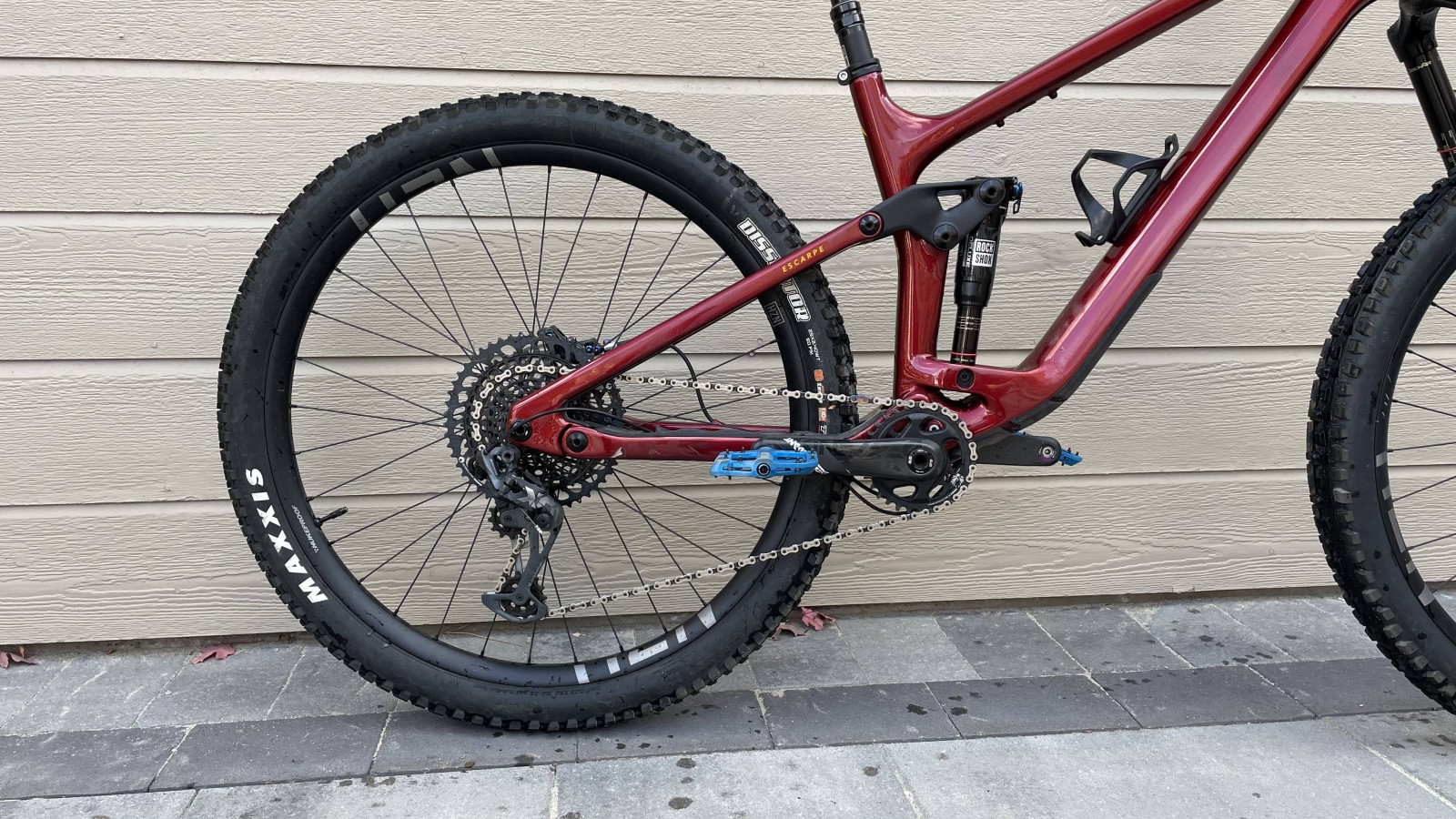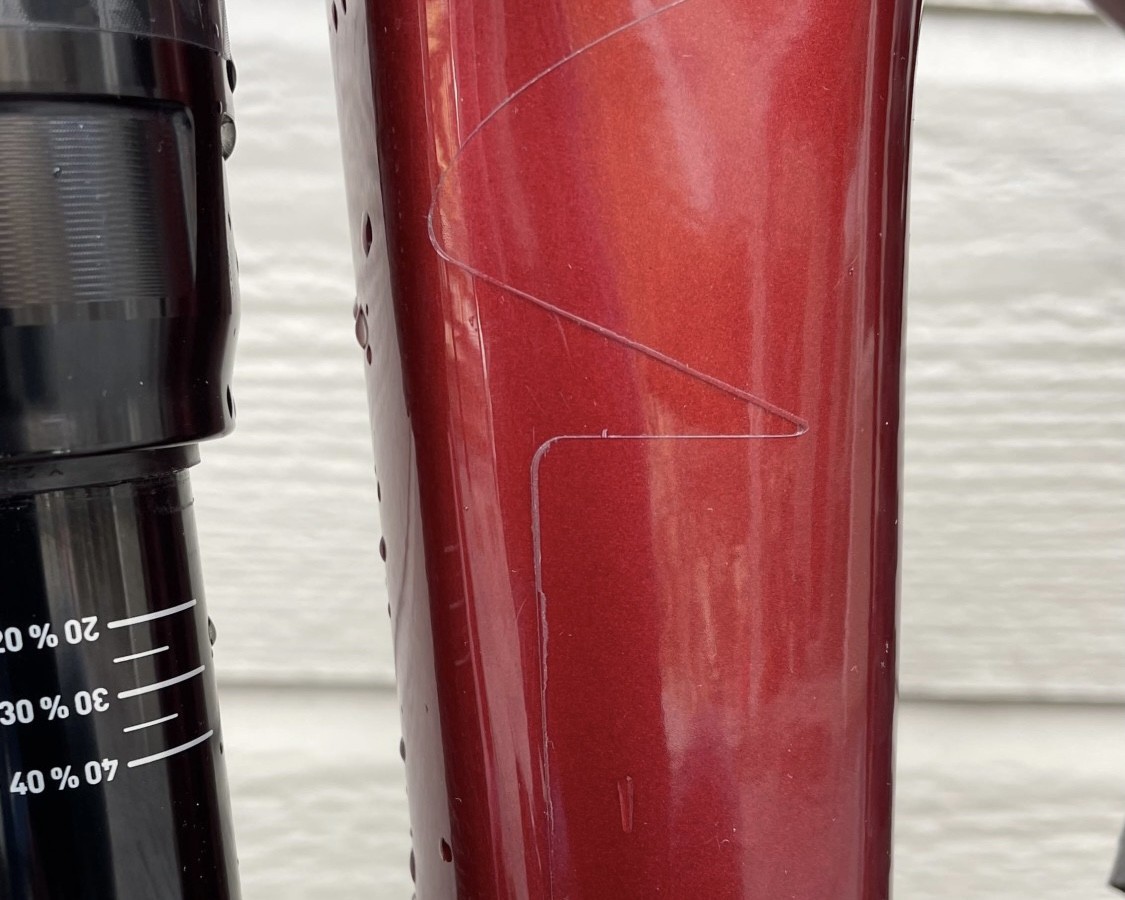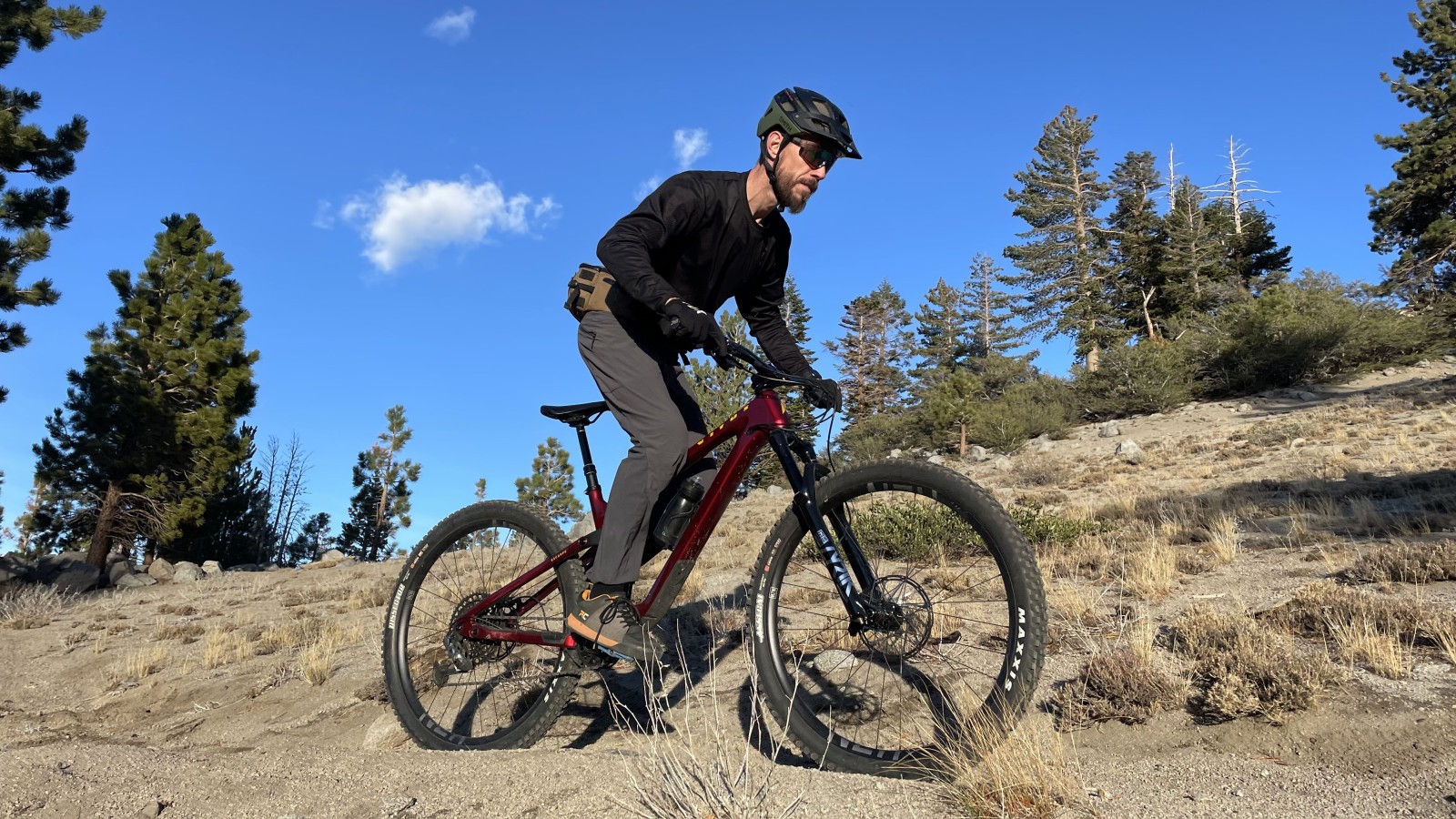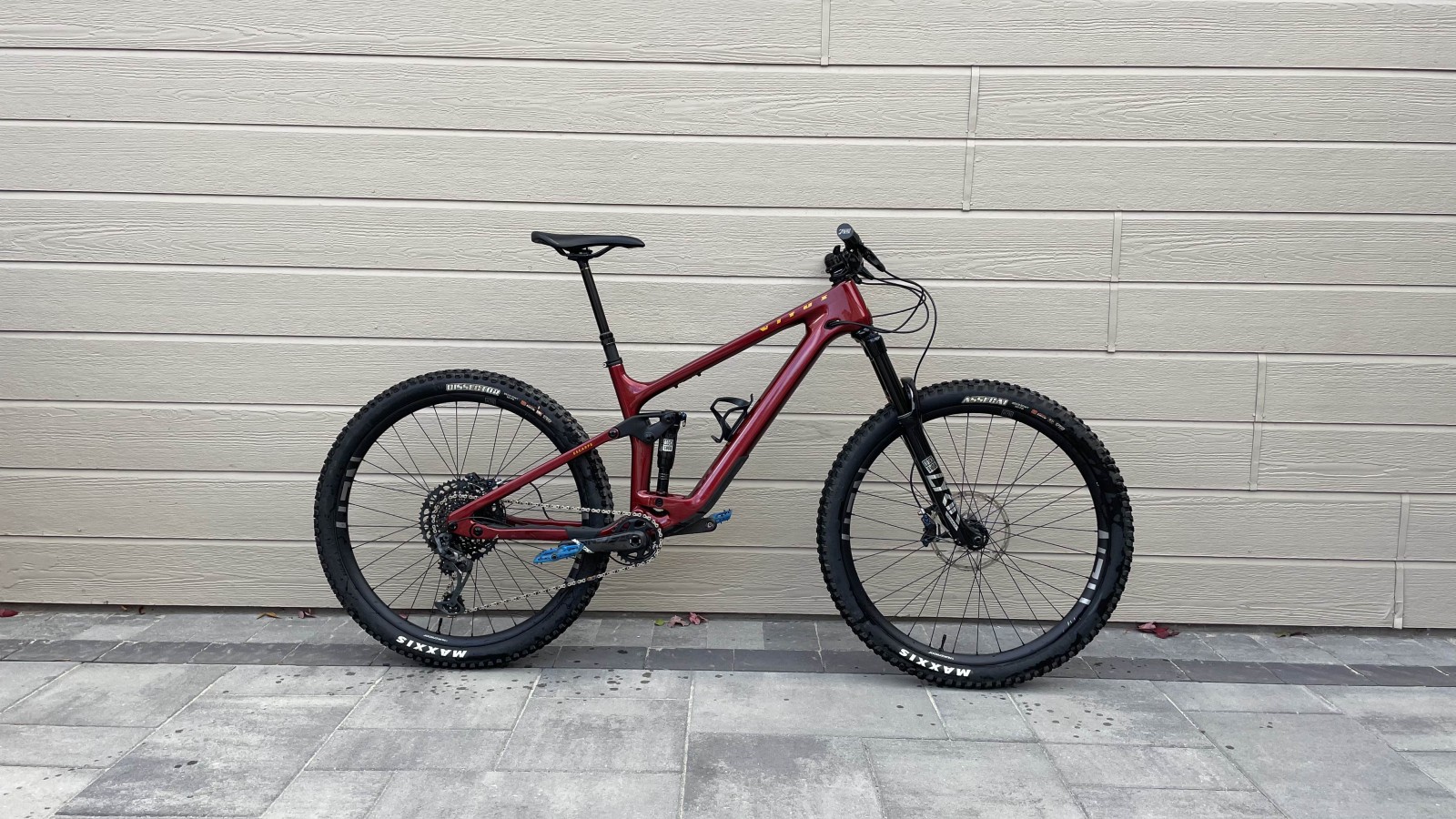If you are like us, you don't discriminate when it comes to getting out and riding trails. We ride all kinds of trails, searching for the best views, dirt, or company. Owning a mountain bike is an obvious necessity because riding is central to who we are, and our mountain bike is the glue holding it all together. The folks at Vitus (apparently pronounced Vee-tus) had that in mind when they developed the Escarpe 29, their mid-travel trail slayer with true all-mountain capabilities. The Escarpe is down to ride anything, anytime. Just like you and just like us.
Highlights
- Carbon fiber frame (aluminum rear triangle depending on build)
- 29-inch wheels
- 140mm (5.5-inches) of rear wheel travel // 150mm (5.9-inches) of fork travel
- Two position flip chip adjusts the head tube angle and bottom bracket height
- Guided internal cable routing
- 65-degree head tube angle (low geo position)
- Size-specific effective seat tube angle
- 440mm chainstay length
- 12 x 148 Boost rear hub spacing
- Rubber chainstay, seat stay, and downtube protector
- Measured weight (size L, no pedals): 30.2 pounds (13.7 kg)
- Sizes: S to XL
- MSRP: $2,799 - $5,999 USD (as tested, AMP 29 model: $5,999 USD)
Strengths
|
Weaknesses
|

Many smaller direct-to-consumer brands have fought hard for a place at the table with established brands like Canyon or YT. Despite any preconceived notions labeling Vitus as a "value brand," we can assure you that they have earned a place at the table with a range of high-performing, aggressive trail bikes with friendly price tags. And very soon, riders in the United States will be able to purchase a bike directly from Vitus' website, with orders fulfilled through their new Salt Lake City warehouse. Bikes will ship in a fully recyclable and reusable cardboard box, requiring minimal assembly.
Escarpe Build Kits
The AMP 29 model we tested is the top offering in the Escarpe range. Tipping the scale at only 30.2 lbs (13.6 kgs), it sports a full carbon frame, top-level SRAM components and retails for $5,999 USD. Yes, that is still a hefty hunk of change, but it is considerably less than what other brands ask for their highest-end models. The Escarpe CRX model, built with the same full carbon frame and mix of FOX Factory and Shimano XT components, weighs only half a pound more and retails for $4,799 USD. The Escarpe CRS ($3,899 USD) and CR ($2,799 USD) models use an aluminum rear triangle paired with a carbon front triangle and more modest build kits, weighing in at 31 lbs (14 kgs) and 33.3 lbs (15.1 kgs), respectively.



The Escarpe AMP build touts a T-800 carbon front and rear triangle, finished in a gorgeous octane red. Clear frame protection is preinstalled on high-wear areas, and cables route internally through guides to limit unwanted rattling. The downtube, chainstay, and seatstay feature rubber protectors for extra noise deadening and protection, while the inside of the front triangle offers mounts for a full-size water bottle and tool accessory. Lastly, there is a cable port above the rear shock for running a remote lockout control if your heart desires.
Geometry
The Escarpe utilizes a balanced geometry package with comfortable steep, size-specific effective seat tube angles (same angle for small/medium frame), a 65-degree head tube angle (low geo position), appropriate reach numbers, and 430mm chainstays across the board. In the low setting, the 65-degree head tube angle compliments the ride-everything mentality of the Escarpe. It's still slack enough to party responsibly on the descents yet steep enough to retain great climbing and maneuvering performance. Flipping the chip to the high position will increase the head tube angle to 75.5 degrees and raise the bottom bracket by 6mm.

On The Trail
We tested the Escarpe on our favorite trails in the Sierra Nevada mountains near Reno, Lake Tahoe, and Mammoth Lakes, California. Sky Tavern, in Reno, Nevada, provided us with an ideal testing area where we could repeat several different 2-4 mile loops on trails of varying technical levels. After completing several sessions in loose, dry conditions, typical of late summer and early fall in the American Southwest, mother nature bestowed upon us three days of heavy rain. The subsequent splendor that followed were some of the best trail conditions in recent memory and a reminder that the Escarpe was conceived in the damp hills of Northern Ireland. The two contrasting riding conditions allowed us to compare how the Escarpe handled the same trails in both dry and wet conditions. We also took the Escarpe on a road trip to Mammoth Bike Park, where we had loads of fun finding how much air and demanding terrain this mid-travel trail bike could handle.

The Escarpe is a capable and confident descender, highlighted by its ability to change direction with impressive ease. As we repeated our test lap faster and faster, we loved how aggressively we could push the Escarpe through turns. The 65-degree head tube angle and 42mm offset fork placed our weight evenly over the bike for easy maneuverability. Vitus' choice to spec a stout 150mm RockShox Lyrik instead of a more svelte fork allowed the Escarpe to handle more demanding terrain than we expected. The stiff carbon frame tracked predictably through technical rock gardens, and it was only on the steepest and gnarliest sections of trail where a burlier, longer-travel bike would have been better suited.

The 4-bar linkage and RockShox Deluxe Ultimate shock provide a very efficient pedaling platform, and we didn't find the need to reach for the lockout lever on climbs. At 30% sag in the low position, the Escarpe was planted and smoothed out small to midsize compressions. At the same time, there was enough mid-stroke support to preload the suspensions to pop over obstacles and pump rolling terrain. Using up all 140mm of travel was fairly easy to accomplish on bigger impacts, which prompted us to increase pressure. With more air and only 25% sag, the rear suspension did seem to ramp up quicker, preventing us from bottoming out as frequently, but chatter over small, high-frequency bumps increased. We eventually returned to 30% sag to maximize traction and stability in our loose testing conditions and accepted the occasional harsh bottom out.

We rode Escarpe in the high flip-chip position and felt minuscule differences compared to the stock low position. In the high setting, the leverage curve is slightly more progressive; thus, the bike manages drops and big compressions with more composure. The downside is the rear suspension feels a tad harsher over mid-sized bumps, and the headtube is steeper. If we were to head out on an all-day adventure with plenty of climbing, we could see using the high geometry position to squeak out some extra efficiency from the Escarpe. But for everyday trail riding, the low position with around 30% sag matches the aggressive, capable demeanor of the Escarpe best.

Weighing only 30.2 lbs, we were not surprised by how nimble and responsive the Escarpe felt on the trail. As full-suspension bikes have evolved and been optimized to transport riders efficiently, the importance of overall weight seems to have faded into the background. While plenty of hefty bikes are proficient climbers and perform exceptionally on descents, the Escarpe AMP is a great reminder that lighter bikes accelerate faster, pop higher, and are easier to pedal uphill.
Build Kit
Vitus set out to make the Escarpe AMP as light as possible without compromising its burly nature, and they succeeded with a combination of SRAM, RockShox, and Nukeproof components. Whether we were climbing or descending, smashing through chunks, or sending jumps, we were impressed by the Escarpe's featherweight feel.
SRAM Code RSC Brakes
SRAM Code RSC 4-piston brakes paired with 200mm front and 180mm rear SRAM Centerline rotors provided plenty of stopping power. The Code levers and calipers are uniquely adorned with oil-slick hardware for a touch of bling. Paired with a SRAM 12-speed X01 Eagle drivetrain complete with carbon cranks, the full SRAM package performed with the same industry-leading capability we've come to love throughout many bike reviews.

RockShox Reverb Dropper Post
It seems logical that the SRAM-equipped Escarpe AMP came with a RockShox Reverb Stealth dropper. When Reverbs work like they are supposed to, they are fantastic. Unfortunately, ours was operating super slowly out of the box, so we performed a bleed of the lever and post. This helped for a short time, but over time its performance degraded. On the bright side, the seat post was the only thing that gave us any trouble throughout the test.
Nukeproof Horizon V2 Wheels
We were impressed by the Nukeproof Horizon V2 wheels. They were fast-rolling, smooth, and ready for mayhem. The aluminum Horizon V2 rims feature a 30mm internal width, 35mm external, and 32-spoke configuration front and rear. The rear rim has a slightly thicker sidewall than the front for added strength, and Horizon V2 hubs use premium Enduro bearings that provided fast-rolling, instant engagement throughout testing.
Nukeproof Horizon Cockpit
The cockpit features a 31.8mm-diameter Nukeproof Horizon carbon handlebar, a Nukeproof Horizon stem finished with Nukeproof Sam Hill grips. The 50mm stem is CNC machined and can be mounted with a 5-degree rise or fall, while the carbon bar has a 25mm rise and comes in a sensible 780mm width. We are glad that Vitus decided to go with a more forgiving 31.8mm diameter setup, as we found the cockpit successfully managed trail chatter and kept us from having to peel our hands off the bars after bike park laps.


Fork Performance
A 150mm RockShox Lyrik Ultimate signals to riders that the Escarpe is ready for hard-charging. Ours performed flawlessly throughout testing. We are long-time fans of the Lyrik’s buttery smooth feel in the upper travel and the massive support through the mid-travel.
Maxxis Assegai / Dissector Tire Performance
The tire selection on the Escarpe is well-thought-out for modern, aggressive trail riding. Vitus got it right when they chose to spec all models in the Escarpe range with a 2.5 Maxxis Assegai EXO up front, and a 2.4 Maxxis Dissector EXO+ in the rear. While this is not the fastest-rolling or lightest tire combination, we appreciate the 2.5 up front and heavier casing in the rear. Maxxis Assegai and Dissector are equally aggressive and tackled the loosest and gnarliest terrain with confidence. Knowing that we had a more durable casing in the rear gave us peace of mind when blasting through rocky segments.
Long Term Durability
Seeing that the Escarpe was engineered in-house by Vitus in the rainy hills of Belfast, we feel pretty good about how the Escarpe's chassis and bearings will hold up against the elements. The pre-installed frame wrap is nicely executed right out of the box and has yet to bubble or begin peeling. The downtube and chainstay protectors have also remained in place through testing. Our only concern lies with the RockShox Reverb dropper post and whether or not it will continue to need bleeding in the future. Vitus offers a 5-year warranty on all frames and a 2-year warranty on all components, excluding wear and tear items like tires or brake pads, so the Reverb is covered.

What's The Bottom Line?
The Escarpe 29 is a highly capable all-around trail bike ideal for riders with an appetite for speed who want a confidence-inspiring bike that will foster progression. Lightweight, maneuverable and efficient, the Escarpe is built for a wide range of trails. With entry-level builds starting at $2,799 USD and high-end builds only topping out at $5,999 USD, Vitus has made high-quality, trail bliss attainable for a broad range of riders. For those who reach for the most expensive AMP 29 we tested, you will be rewarded with the lightest build in the range and top-tier components from SRAM and RockShox that are ready to roll right out of the box.
For more information, please visit www.vitusbikes.com
Vital MTB Rating
Overall Impression: 4.5 stars - 5
View key specs, compare bikes, and rate the Vitus Escarpe in the Vital MTB Product Guide.
____________________________________________________________________________
About The Reviewer
John Armbruster // Age: 43 // Years Riding MTB: 20 // Height: 5'10" (1.78m) // Weight: 155-pounds (70kg)
John has spent enough time mountain biking to witness the technical evolution of our sport and its bikes. Fads have come and gone but the fun never dies. He won't say no to a new trail or another lap, and when the bikes are clapped, John has the mechanical experience to revive his rigs from the ground up. Once resuscitated, he's back on the trail, clocking the miles, vert, and shenanigans.







View replies to: $5,999 2022 Vitus Escarpe AMP 29 Review
Comments